what happened to the native americans during the westward expansion

W Expansion by Currier & Ives, 1866.
From the earliest days of European settlement on the Atlantic Coast, pioneers began moving west to obtain land, trade, and raise families. From the showtime, there were Native Americans occupying these lands which created numerous conflicts as the natives tried to maintain their lifestyles.
By 1790, the U.s. government had claimed all the country eastward of the Mississippi River and many of the tribes would soon exist uprooted and forced to move west. After the Louisiana Purchase in 1803, Americans pushed further westward into territories claimed past United mexican states and Britain. Manifest Destiny, a phrase coined in 1845, came to encompass the belief in the inevitable territorial expansion of the The states from the Atlantic to the Pacific.
By the time of the California Gold Rush in 1849, overland trails had already been blazed due west and after the Ceremonious State of war, the Homestead Act was passed in 1862, which sent thousands more than settlers due west. During these years, Native American tribes were made to move from their lands, causing a number of Indian wars.
1851-1900
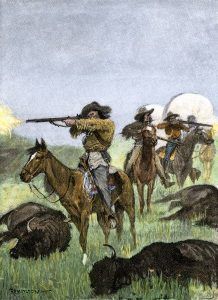
Hunting buffalo.
1850– There are 20,000,000 buffalo on the plains between Montana and Texas.
On September 9, 1850 – California entered the Union. With miners flooding the hillsides and devastating the land, California's Indians found themselves deprived of their traditional nutrient sources and forced by hunger to raid the mining towns and other white settlements.
1850-1875 – The extermination of buffalo herds by sports and hide hunters severely limits the Plains Indians' food supply and ability to survive.
1851– A series of Fort Laramie treaties were signed with the Lakota, Cheyenne, Arapaho and other Plains tribes delineating the extent of their territories and allowing passage across these territories in exchange for payments to the tribes. Thus began the incursions of miners and railroad vehicle trains on the Oregon and later on the Bozeman Trail, few at first merely an onslaught after the end of the Civil War.
Federal commissioners attempting to halt the brutal handling of Indians in California negotiated xviii treaties with diverse tribes, promising them 8.5 million acres of reservation lands. However, California politicians succeeded in having the treaties secretly rejected by Congress in 1852, leaving the natives homeless within a hostile white social club.
On August 5, 1851, Santee Sioux Chief Little Crow signed a treaty with the federal authorities, ceding nearly all his people'due south territory in Minnesota. Though non happy with the agreement, he abided by it for many years.
1853 – California began circumscribed its remaining Indian population on harsh military reservations, but the combination of legal enslavement and near genocide had already made California the site of the worst slaughter of Native Americans in United States history. As many as 150,000 Indians lived in the land earlier 1849; by 1870, fewer than 30,000 remained.
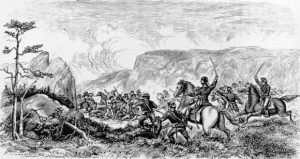
Ash Hollow Massacre, Nebraska.
1855 – On September iii, 1855, the Ash Hollow Massacre occurred in Nebraska. Colonel William Harney used one,300 soldiers to massacre an entire Brule village in retribution for the killing of xxx soldiers, who were killed in retribution for the killing of Brule Chief Acquisition Behave, in a dispute over a cow.
1856 – On Jan 26, 1856, in the Battle of Seattle, settlers drove Indians from their state and so that a picayune town of white settlers could prosper. The sloop Decatur fired its cannon, routing the "Indians." Ii settlers were killed in the fight.
1857 – In September 1857, the Fancher Party, a group of California-leap emigrants from Arkansas and Missouri, arrived in Salt Lake City. According to Brigham Young's edict, the townspeople refused to sell supplies to the group. The carriage railroad train then headed south and camped in Mount Meadows.
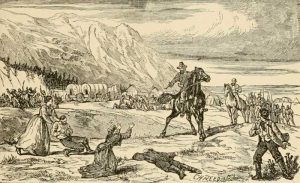
Mountain Meadows Massacre, Utah
On September vii, 1857, the Francher Party suffered a coordinated articulation assault by Paiute Indians and Mormon militiamen. Many were killed on both sides before the pioneers could proceeds a tenable defensive position. And then followed 5 days of siege, in which the emigrants were massacred. When the bloodbath ended, 123 were dead and only 17 young children were left alive. Lee fled the area with his 17 wives and settled in Lee's Ferry, Arizona.
1858– On May 17, 1858, one,200 Coeur d'Alene, Palouse, Spokan, and Skitswich Indians defeated a potent force of Colonel Steptoe nigh Colfax, Washington, at the village of To-ho-to-nim-me.
On September 17, 1858, Colonel Wright dictated terms of give up to Indians at Coeur d'Alene mission. 20-iv chiefs of the Yakama, Cayuse, Wallawalla, Palouse, and Spokan tribes were shot or hanged.
1860 – On Feb 26, 1860, white settlers from Eureka, California attacked and killed 188 members of the Wiyot Tribe on Indian Isle in Humboldt Bay. But ane Wiyot member survived — a kid named Jerry James, who was the son of chief Captain Jim.
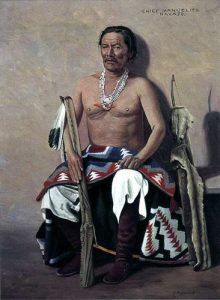
Navajo War Principal Manuelito, by Elbridge Ayer Burbank, 1908
On Apr 29, 1860, Navajo Master Manuelito and his warriors attacked Fort Defiance in northeastern Arizona. The fort, the first built in Navajo state, was almost livestock grazing country used by the Navajo. The conflict began when the ground forces claimed the grazing land for their horses.
1860 to 1864 – The Navajo War bankrupt out in New United mexican states Territory every bit a consequence of tensions between the Navajo and American military forces in the expanse. During a final standoff in January 1864 at Canyon de Chelly, fears of harsh winter weather condition and starvation forced the Navajo to surrender to Kit Carson and his troops. Carson ordered the destruction of Navajo holding and organized the Navajo Long Walk to Bosque Redondo reservation at Fort Sumner, New Mexico.1861
1861 – On February 13, 1861, the first war machine activity to effect in the Congressional Medal of Honor occurred. Colonel Bernard Irwin attacked and defeated hostile Chiricahua Indians in Arizona.
On February 18, 1861, the Arapaho and Cheyenne ceded most of eastern Colorado, which had been guaranteed to them forever in an 1851 treaty.
On June 11, 1861, rancher Nathan Hungate, his wife, and two little girls were slaughtered in Chivington, Colorado past Indians.
On September 22, 1861, in an unprovoked peacetime attack, U.S. Army soldiers massacred visiting Navajo men, women, and children during a horse race at Fort Wingate, New Mexico.
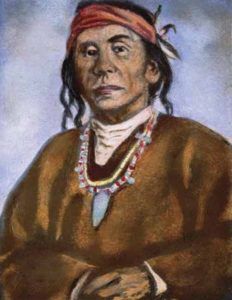
Chiricahua Apache Master Cochise
On September 22, 1861, 500 Apache led past Cochise attacked the town of Pinos Altos, New Mexico. Three miners and 14 Indians were killed.
On November 29, 1861, 750 Colorado volunteers of the tertiary Colorado Cavalry, nether the command of Colonel John Chivington, attacked a Cheyenne and Arapaho hamlet in Colorado in retaliation for the Hungates. In what is known every bit the Sand Creek Massacre, 163 Indians were killed; 110 of them were women and children. Afterward andthe soldiers scalped the victims, mutilated bodies and the expressionless were left to exist eaten by coyotes and vultures.
1862 – Congress passes the Homestead Deed making western lands belonging to many Indian Nations bachelor to non-Indian American settlers.
August xviii, 1862 – The Sioux Uprising (or Santee War) in Minnesota began. The Sioux declared war on the white settlers, killing more than ane,000. They were eventually defeated past the U.S. army, which marched i,700 survivors to Fort Snelling. Others escaped to the safety of their western relatives. Over 400 Indians were tried for murder, 38 of whom were publicly executed. Past 1864 90% of the Santee, and many of the Teton who sheltered them were dead or in prison house.
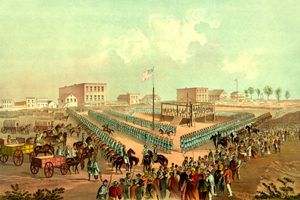
Execution of 38 Sioux, Mankato Minnesota, December 26, 1862
December 26, 1862 – The mass execution of 38 Sioux men in Mankato, Minnesota for crimes during the Sioux Uprising. The trials of almost every developed male who had voluntarily surrendered to General Sibley, at a rate of up to 40 a 24-hour interval, were conducted under the premise of guilty until proven innocent. Originally 303 men were condemned to death. President Abraham Lincoln intervened and ordered a complete review of the records which reduced the listing to 38.
1863 – Subsequently the end of the Santee Sioux uprising, Little Crow left the surface area. Eventually, he returned to steal horses and supplies so he and his followers could survive. On July iii, 1863, Little Crow was killed for a bounty of $25 and his son escaped.
1864 – The Long Walk to Bosque Redondo – Under the military leadership of Kit Carson, the federal authorities forced 8,000 Navajo men, women, and children to walk more than 300 miles from their ancestral homeland in northeastern Arizona to a newly-designated reservation at Bosque Redondo in northwestern New Mexico.
1865 – In July 1865, General Patrick Conner organized three columns of soldiers to begin an invasion of the Pulverization River Basin, from the Black Hills to the Big Horn Mountains. They had 1 order: "Assail and kill every male person Indian over twelve years of age."
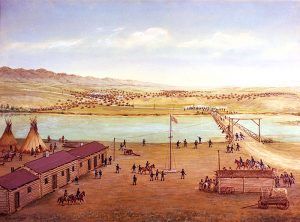
Platte Span Station, Casper, Wyoming past William Henry Jackson
July 24-26, 1865 – The Battle of Platte Span, Wyoming occurs when the Cheyenne and Lakota besiege the most northerly outpost of the U.S. Regular army. The Indians succeeded in killing all members of a platoon of cavalrymen sent out to meet a wagon railroad train likewise every bit the wagon drivers and their escorts.
Late August 1865 – The Boxing of Natural language River occurs in Wyoming when General Patrick Conner's cavalcade destroys an Arapaho village, including all the winter'southward food supply, tents, and wearing apparel. They kill over fifty of the Arapaho villagers.
Belatedly September 1865 – Roman Nose's Fight occurs when the Cheyenne Chief, in revenge for the Sand Creek Massacre, led several hundred Cheyenne warriors in a siege of the Cole and Walker columns of exhausted and starving soldiers who were attempting to return to Fort Laramie. Because they were armed only with bows, lances and a few onetime trade guns, they were unable to overrun the soldiers, only they harassed them for several days until Connor'southward returning column rescued them.
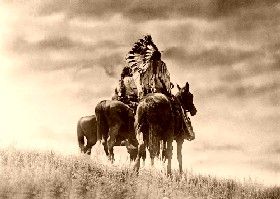
Cheyenne Warriors by Edward S. Curtis
Oct 14, 1865 – The Southern Cheyenne chiefs sign a treaty agreeing to cede all the state they formerly claimed every bit their own, most of Colorado Territory, to the U.S. government. This was the desired finish of the Sand Creek Massacre.
October 1865 – General Patrick Conner returns to Fort Laramie leaving two companies of soldiers at the fort they had synthetic at the fork of the Crazy Woman Creek and the Powder River. Red Cloud and his warriors kept these men isolated and without supplies all wintertime. Many died of scurvy, malnutrition, and pneumonia earlier winter'southward cease. They were not relieved until June 28th by Colonel Carrington's company.
Late Fall, 1865 – Ix treaties were signed with the Sioux including the Brule, Hunkpapa, Oglala, and Minneconjou. These were widely advertised as signifying the end of the Plains wars although none of the war chiefs had signed any of these treaties.
December 21, 1865 – An illegal Executive Society removed lands from the Oregon Coast Indian Reservation, cutting the territory in half.
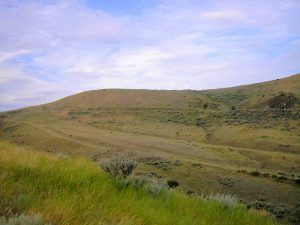
Bozeman Trail, Montana past Kathy Weiser-Alexander
1866 – The Sioux Nations are angered equally the U.S. Army begins building forts along the Bozeman Trail, an important road to the goldfields of Virginia City, Montana. Captain Fetterman and lxxx soldiers are killed.
Apr one, 1866 – Congress overrides President Johnson's veto of the Civil Rights Bill, giving equal rights to all persons born in the U.S. (except Indians). The President is empowered to utilize the Ground forces to enforce the constabulary.
Late Spring 1866 – State of war chiefs Cherry-red Cloud, Spotted Tail, Standing Elk, Tiresome Knife, and others come to Fort Laramie to negotiate a treaty concerning access to the Powder River Basin. Shortly subsequently the beginning of the talks, on June 13, Colonel Henry Carrington and several hundred infantrymen reached Fort Laramie to build forts along the Bozeman Trail. Information technology was clear to the chiefs that the treaty was a mere formality; the road would be opened whether they agreed or not. This was the outset of Red Cloud's State of war.
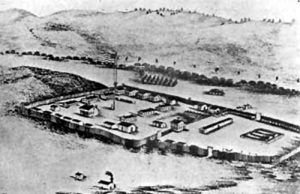
Fort Phil Kearny, Wyoming
July 13, 1866 – Colonel Carrington begins building Fort Phil Kearny in Wyoming. He halts his column between the forks of the Piddling Piney and the Big Piney Creeks, in the best hunting grounds of the Plains Indians, and pitches camp. The Cheyenne visit and decide that the camp is too strong for them to attack directly and begin plans for harassing the soldiers who leave the military camp and for drawing out soldiers past using decoys. All summer they harassed the soldiers and brand alliances with other Plains groups, forming a coalition of Lakota, Cheyenne, Arapaho and Crow groups.
December 21, 1866 – The Fetterman Massacre was fought virtually Fort Phil Kearny, Wyoming Territory. Angered at white interlopers traveling through their country, Sioux and Cheyenne forces continually harassed the soldiers at Fort Phil Kearny, constructed to provide emigrant protection along the newly opened Bozeman Trail. Out maneuvering the soldiers, the Indians killed all fourscore of them.
Pages: one ii 3 iv
Source: https://www.legendsofamerica.com/native-american-timeline-westward-expansion/
0 Response to "what happened to the native americans during the westward expansion"
Post a Comment